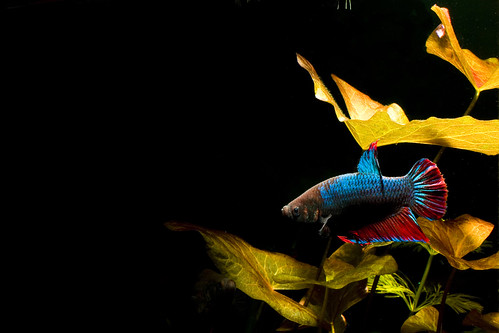DO wrote,
I received a 1 gal. wall bowl w/ bamboo plant, few rocks and red male Betta in March as an anniversary gift from my husband. Up until 1.5 weeks ago he was active, had a routine, seemed happy and healthy. We went out of town for the weekend, I left him a sinkable disc food. It was his 1st time alone. After our return I immediately changed the water as it was very cloudy. His gills were protruding and he seemed to be gasping? After clean water he seemed to perk up, but didn't completely return to his old self. 4 days ago he stopped eating. I thought maybe he was cold so I place a light above him a few hours a night. He swims to it and hangs out where it is warm. Yesterday he did his morning "dancing" asking for breakfast, which I took as a good sign, but still won't eat. He doesn't seem to have ick, or any physical damage (besides gills). I am getting very concerned about him. My children keep asking about him. I change his water 1-2 times a week, boil/cool rocks in between as well as rinse off bamboo. His head does look a little gray but not fuzzy the last 2 days or so. Any advise would be great, thanks.
A: This is a classic case of ammonia poisoning with all the signs. Fish waste and decaying food are the primary sources for toxic ammonia. In such a small bowl ammonia can build to toxic levels in a very short amount of time (a few days under normal conditions) and that problem can be compounded by adding extra food or missing a water change.
Swollen gills and gasping are typical symptoms of ammonia burns. Unfortunately, these burns are slow to heal and often never fully return to normal function. When Bettas struggle to get oxygen they often experience secondary problems including loss of appetite, faded color or secondary infections. This is due to the added stress on the immune system.
Some steps you can take to increase your Betta's chance of recovery are keep up with frequent water changes, test for ammonia regularly using a simple ammonia test kit from your local fish store and supply your fish with an appropriately sized aquarium (3 - 5 gallons minimum). Aquarium salt can also be beneficial to
help relieve stress and increase gill function for fish who have experienced ammonia burns. The dosage is 1 tablespoon for every 5 gallons of water and remember that salt does not evaporate so don't continue to add salt to the bowl or it will reach unsafe concentrations.
The single best thing you can do to improve water quality and provide a stable home for your fish is to cycle an aquarium. The "nitrogen cycle" is a naturally occurring process that happens in an aquarium (and all bodies of water) where beneficial bacteria reproduce and grow and consume dangerous ammonia as it is being produced. Tank cycling is something that few fish keepers know about when the first buy their fish (unfortunately most fish stores don't educate their patrons) but eventually learn about the process once their fish begin to get sick. I put together a web page for new Betta keepers describing the process so they can easily cycle their first aquarium. Cycling a fish tank will help you combat future ammonia problems, will create a safer healthier environment for your fish and will save you time and money by reducing the frequency of water changes. To learn about the nitrogen cycle visit
This is a very common problem with new Betta keepers and I know your question will help many others experiencing the same problem. Good luck to you and I hope your fish will experience a full recover as soon as possible.


